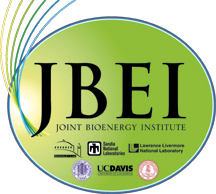
A partnership of three national laboratories — including Sandia — and three research universities in the San Francisco Bay Area has been chosen to host one of three national bioenergy research centers, Secretary of Energy Samuel Bodman announced last week.
The center will be funded by DOE through its Biological and Environmental Research Genomics: GTL research program in the Office of Science.
Lawrence Berkeley National Laboratory (Berkeley Lab) will lead the new center, which will be known as the DOE Joint BioEnergy Institute (JBEI). It is expected to receive $125 million in DOE funding over its first five years.
The DOE JBEI’s other partners are Lawrence Livermore National Laboratory (LLNL), the University of California (UC) campuses in Berkeley and Davis, and Stanford University. Plans call for the center to be headquartered in a leased building in the East Bay area, central to all partners. Initial work will take place at the West Berkeley Biocenter in Berkeley.
“The DOE bioenergy research centers will provide the transformational science needed for bio-energy breakthroughs to advance President Bush’s goal of making cellulosic ethanol cost-competitive with gasoline by 2012, and assist in reducing America’s gasoline consumption by 20 percent in 10 years,” Bodman says. “The collaborations of academic, corporate, and national laboratory researchers represented by these centers are truly impressive and I am very encouraged by the potential they hold for advancing America’s energy security.”
Two Sandians on management team
Two Sandians will serve on the JBEI management team: Blake Simmons (8755) as vice president of deconstruction and Kathe Andrews-Cramer (8333) as vice president of strategic integration. Other members include Jay Keasling, CEO of Berkeley Lab, vice president of fuels synthesis; Harvey Blanch, Berkeley Lab/UC Berkeley, chief science and technology officer; Wolf Frommer, Stanford University, vice president of feedstocks; and Paul Adams, Berkeley Lab, vice president of technology.
Research at the institute will focus on biofuels — liquid fuels derived from the solar energy stored in plant biomass. Harnessing even a tiny fraction of the total solar energy available each year could meet most if not all of the nation’s annual transportation energy needs.
Transforming biofuels research
“Diversifying our energy supply is a critical priority for the nation. Achieving that goal will require new scientific breakthroughs and rapid translation of science into scalable technologies,” says Sandia President Tom Hunter. “This partnership will enable a synthesis of biosciences and engineering that will transform the nation’s biofuel research capabilities. With the Joint BioEnergy Institute, Sandia joins California’s extraordinary national laboratories and leading research universities as we move forward to set a new standard for renewable energy research.”
Sandia’s role in the center will build on the Labs’ expertise in science-based engineering, computational science, and microsystems.
Sandia’s capabilities in enzyme engineering, systems biology, membrane transport, protein expression, and hyperspectral imaging are expected to contribute significantly to the JBEI mission.
Sandia’s Center for Integrated Nanotechnologies (jointly operated with Los Alamos National Laboratory), the Microsystems and Engineering Sciences Applications (MESA) complex, and the Combustion Research Facility will play leading roles. Current bioenergy-related research at Sandia expected to enhance DOE JBEI efforts includes the examination of the photosynthetic properties of various plants and microbes; analysis of extremophile enzymes; and related engineering methods that can facilitate the processing of cellulosic biomass.
Scientific studies have consistently ranked biofuels among the top candidates for meeting large-scale energy needs, particularly in the transportation sector. However, the commercial-scale production of clean, efficient, cost-effective bio-fuels will require technology-transforming scientific breakthroughs.
Converting biomass to biofuel
Researchers at the DOE JBEI intend to meet this challenge through the conversion of lignocellulosic biomass into biofuels. Lignocellulose, the most abundant organic material on the planet, is a mix of complex sugars and lignin that gives strength and structure to plant cell walls. By extracting simple fermentable sugars from lignocellulose and producing biofuels from them, the potential of the most energy-efficient and environmentally benign fuel crops can be realized.
Researchers will tackle key scientific problems that currently hinder the cost-effective conversion of lignocellulose into biofuels and other important chemicals. They will also develop the tools and infrastructure to accelerate future biofuel research and production efforts, and help transition new technologies into the commercial sector. The goal of the center is to achieve measurable success within the next five years.
The organization of the center will feature four interdependent science and technology divisions:
- Feedstocks, aimed at improving plants that serve as the raw materials for ethanol and the next generation of biofuels.
- Deconstruction, aimed at investigating the molecular mechanisms behind the breakdown of lignocellulose into fermentable sugars.
- Fuels synthesis, in which microbes that can efficiently convert sugar into biofuels will be engineered.
- Cross-cutting technologies, which will be dedicated to the development and optimization of enabling technologies that support and integrate DOE JBEI research.
In addition to maintaining an Industry Partnership Program, research at the center will be guided by an Industry Advisory Board whose membership will come from key sectors, including feedstocks, enzymes, fuels production, biotechnology, genetics, and chemistry.
Each of the member institutes of the DOE JBEI brings unique capabilities to the partnership. The national laboratory partners operate state-of-the-art scientific instrumentation and research facilities. In addition to the Sandia facilities, other assets include the Molecular Foundry, the Advanced Light Source, and the National Center for Electron Microscopy at Berkeley Lab; and the Center for Accelerator Mass Spectrometry and the MicroArray Center at LLNL.
The other two DOE Bioenergy Research Centers are the DOE BioEnergy Research Center, led by the Oak Ridge National Laboratory in Oak Ridge, Tenn., and the DOE Great Lakes Bioenergy Research Center, led by the University of Wisconsin in Madison, Wisc., in close collaboration with Michigan State University in East Lansing, Mich.
For more information on DOE JBEI, visit www.jbei.org.